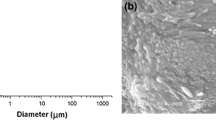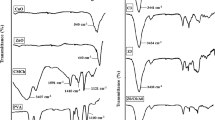Abstract
The effect of chitosan addition on the structure and drug release properties of ureasil–polyethylene oxide (U–PEO) hybrid materials was examined. The hybrids and the blends were prepared by the sol–gel route and their structural features were characterized by infrared spectroscopy, differential scanning calorimetry, X-ray powder diffraction, and small angle X-ray scattering. The different characterization techniques revealed the formation of transparent, rubbery, flexible, water-insoluble, and low crystalline chitosan/(U–PEO hybrid) blends, which could easily dissolve pramoxine (used as a model drug). The results showed that the combined addition of chitosan and pramoxine improved the compatibility of the organic and inorganic components of the U–PEO matrix, and provided a means of tailoring the amount of drug released at steady state equilibrium.





Similar content being viewed by others
References
Sanchez C, Belleville P, Popall M, Nicole L (2011) Applications of advanced hybrid organic–inorganic nanomaterials: from laboratory to market. Chem Soc Rev 40:696–753
Nicole L, Rozes L, Sanchez C (2010) Integrative approaches to hybrid multifunctional materials: from multidisciplinary research to applied technologies. Adv Mater 22:3208–3214
Sanchez C (2005) State of the art developments in functional hybrid materials. J Mater Chem 15:3557–3558
Benvenutti EV, Moro CC, Costa TM (2009) Materiais híbridos à base de sílica obtidos pelo método sol–gel. Quim Nova 32:1926–1933
Molina EF, Pulcinelli SH, Santilli CV, Briois V (2012) Ligand exchange inducing efficient incorporation of cisPt derivatives into ureasil–PPO hybrid and their interactions with the multifunctional hybrid network. J Phys Chem B 116:7931–7939
Molina EF, Pulcinelli SH, Santilli CV, Blanchandin S, Briois V (2010) Controlled cisplatin delivery from ureasil–PEO1900 hybrid matrix. J Phys Chem B 114:3461–3466
Lopes L, Molina EF, Chiavacci LA, Santilli CV, Briois V, Pulcinelli SH (2012) Drug–matrix interaction of sodium diclofenac incorporated into ureasil–poly(ethylene oxide) hybrid materials. RSC Adv 2:5629–5636
Santilli CV, Chiavacci LA, Lopes L, Pulcinelli SH, Oliveira AG (2009) Controlled drug release from ureasil–polyether hybrid materials. Chem Mater 21:463–467
Souza LK, Bruno CH, Lopes L, Pulcinelli SH, Santilli CV, Chiavacci LA (2013) Ureasil–polyether hybrid film-forming materials. Colloids Surf B: Biointerfaces 101:156–161
Wu N, Wang L, Tan DC, Moochhala SM, Yang Y (2005) Mathematical modeling and in vitro study of controlled drug release via a highly swellable and dissoluble polymer matrix: polyethylene oxide with high molecular weights. J Control Release 102:569–581
Silva GS, Oliveira PC, Giordani DS, Castro HF (2011) Chitosan/siloxane hybrid polymer: synthesis, characterization and performance as a support for immobilizing enzyme. J Braz Chem Soc 22:1407–1417
Tyukova IS, Suvorova AI, Okuneva AI, Shishkin EI (2010) Preparation and structure of chitosan–silica organic–inorganic hybrid films. Polym Sci B 52:564–570
Silva SS, Ferreira RAS, Fu L, Carlos LD, Mano JF, Reis RL, Rocha J (2005) Functional nanostructured chitosan–siloxane hybrids. J Mater Chem 15:3952–3961
Hu L, Sun Y, Wu Y (2013) Advances in chitosan-based drug delivery vehicles. Nanoscale 5:3103–3111
Patel MP, Patel RR, Patel JK (2010) Chitosan mediated targeted drug delivery system: a review. J Pharm Pharmaceut Sci 13:536–557
Riva R, Ragelle H, Rieux A, Duhem N, Jerome C, Preat V (2011) Chitosan and chitosan derivatives in drug delivery and tissue engineering. Adv Polym Sci 244:19–44
Agnihotri SA, Mallikarjuna NN, Aminabhavi TM (2004) Recent advances on chitosan-based micro- and nanoparticles in drug delivery. J Control Release 100:5–28
Hejazi R, Amiji M (2002) Stomach-specific anti-H. pylori therapy. I: preparation and characterization of tetracyline-loaded chitosan microspheres. Int J Pharm 235:87–94
Manchun S, Dass CR, Sriamornsak P (2012) Targeted therapy for cancer using pH-responsive nanocarrier systems. Life Sci 90:381–387
Bostan MS, Senol M, Cig T, Peker I, Goren AC, Ozturk T, Eroglu MS (2013) Controlled release of 5-aminosalicylic acid from chitosan based pH and temperature sensitive hydrogels. Int J Biol Macromol 52:177–183
Popat A, Liu J, Lu GQ, Qiao SZ (2012) A pH-responsive drug delivery system based on chitosan coated mesoporous silica nanoparticles. J Mater Chem 22:11173–11178
Kucukoglu K, Tanol M (2010) Synthesis of some pramoxine-based compounds as possible local anesthetic and anticholinergic agents. Asian J Chem 22:3404–3412
Davidenko N, Peniche C, Diaz JM, Roman JS, Sastre R (2007) Photopolymerisation of acrylic acid and chitosan gels. (I) Influence of preparation method on the formation and kinetic behaviour of interpenetrating complexes. Latin Am Appl Res 37:247–253
George TS, Guru KSS, Vasanthi NS, Kanan KP (2011) Extraction, purification and characterization of chitosan from endophytic fungi isolated from medicinal plants. World J Sci Technol 1:43–48
Santos JE, Soares JP, Dockal ER, Campana SP, Cavalheiro ETG (2003) Caracterização de quitosanas comerciais de diferentes origens. Polímeros: Ciência e Tecnologia 13:242–249
Pramoxine hydrochloride (2011) National Institute of Standards and Technology (NIST). http://webbook.nist.gov/cgi/cbook.cgi?ID=B6005107&Mask=80. Accessed 24 Oct 2013
Hikosaka MY, Pulcinelli SH, Santilli CV, Dahmouche K, Craievich AF (2006) Montmorillonite (MMT) effect on the structure of poly(oxyethylene) (PEO)–MMT nanocomposites and silica–PEO–MMT hybrid materials. J Non-Cryst Solids 352:3705–3710
Chaker JA, Santilli CV, Pulcinelli SH, Dahmouche K, Briois V, Judeinstein P (2007) Multi-scale structural description of siloxane–PPO hybrid ionic conductors doped by sodium salts. J Mater Chem 17:744–757
Molina E, Marçal L, Pereira HW, Nassar EJ, Ciuffi KJ (2013) Tri-ureasil gel as a multifunctional organic–inorganic hybrid matrix. Polym Chem 4:1575–1582
Craievich A (2005) Small-angle X-ray scattering by nanostructured materials. In: Sakka S, Almeida R (eds) Handbook of sol–gel science and technology, vol 2, 1st edn. Kluwer, Dordrecht, pp 161–189
Acknowledgments
This work received financial support from CAPES (Coordenação de Aperfeiçoamento de Pessoal de Nível Superior), CNPq (Conselho Nacional de Desenvolvimento Científico e Tecnológico), and FAPESP (Fundação de Amparo à Pesquisa do Estado de São Paulo).
Author information
Authors and Affiliations
Corresponding author
Rights and permissions
About this article
Cite this article
Paredes, M., Pulcinelli, S.H., Peniche, C. et al. Chitosan/(ureasil–PEO hybrid) blend for drug delivery. J Sol-Gel Sci Technol 72, 233–238 (2014). https://doi.org/10.1007/s10971-014-3314-8
Received:
Accepted:
Published:
Issue Date:
DOI: https://doi.org/10.1007/s10971-014-3314-8




